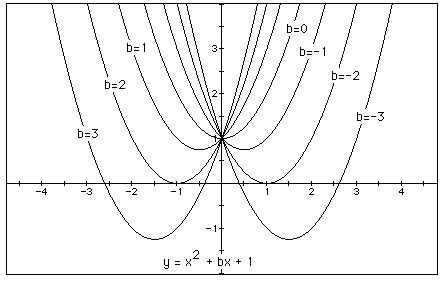

Assignment 3: Locus of ax2 + bx + c = 0
by Shawn Broderick
For this assignment, I have chosen to do the first question.
To refresh our memory of the directions and explanation:
Investigation 1.
It has now become a rather standard exercise, with availble technology, to construct graphs to consider the equation ax2 + bx + c = 0 and to overlay several graphs of y = ax2 + bx + c for different values of a, b, or c as the other two are held constant. From these graphs discussion of the patterns for the roots of ax2 + bx + c = 0
can be followed. For example, if we set y = x2 + bx + 1 for b = -3, -2, -1, 0, 1, 2, 3, and overlay the graphs, the following picture is obtained:

We can discuss the "movement" of a parabola as b is changed. The parabola always passes through the same point on the y-axis ( the point (0,1) with this equation). For b < -2 the parabola will intersect the x-axis in two points with positive x values (i.e. the original equation will have two real roots, both positive). For b = -2, the parabola is tangent to the x-axis and so the original equation has one real and positive root at the point of tangency. For -2 < b < 2, the parabola does not intersect the x-axis -- the original equation has no real roots. Similarly for b = 2 the parabola is tangent to the x-axis (one real negative root) and for b > 2, the parabola intersets the x-axis twice to show two negative real roots for each b.
Now consider the locus of the vertices of the set of parabolas graphed from y = x2 + bx + 1. Without calculus, show that the locus is a parabola. We shall proceed from here to show how to find the locus of this equation without calculus.
This investigation is going to be carried out in Geometer's Sketchpad.
File: assignment3.gsp